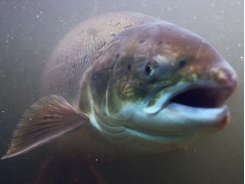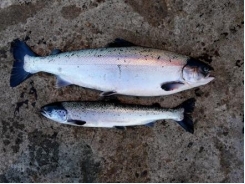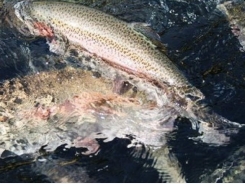Watching ocean currents may limit disease spread on salmon farms

Planning best location for aquaculture facilities and knowledge of which facilities to use can prevent disease spread. Photo: Shutterstock
Currents in the ocean and fjords spread viruses that are killing large numbers of farmed salmon. This raises the questions: Where should fish farms be built? Should they all be in use at the same time? Researchers with the Norwegian University of Science & Technology (NTNU) in Ålesund, Norway, are using computer modeling to figure out how best to site farms to protect fish and the coastline.
Pancreas disease is a viral infection in farmed salmon that causes major economic losses because it reduces how much the fish grow and increases mortality, NTNU said. When farmed salmon are weakened, they also become more susceptible to other diseases.
Pancreas disease can resolve on its own, but mortality is often high. In addition to threatening fish welfare, every year the disease leads to major losses for salmon breeders in Norway. Ocean currents are one of the most important pathways for the disease, carrying the virus from one fish farm to the next, NTNU added.
Planning for the best place to locate aquaculture facilities and knowledge of which facilities to use when combating the disease can prevent the spread of the viruses, new NTNU research shows.
Project researchers monitored ocean currents in the Romsdalsfjord and Nord-Trøndelag in 2014. Data from the observations were transferred to a digital model, where researchers created virtual virus particles. The technology has made it possible to monitor how the disease can spread from one aquaculture facility to another.
"The virus can survive for a long time in Norwegian coastal waters. Since it does have a limited life span, we've also removed the virtual virus in the data model after a while to simulate natural conditions," NTNU associate professor Lars Gansel said.
The researchers have also tested the real virus in the lab. This allowed them to figure out how much of the virus is needed to infect salmon.
Different models
The models show which fish farms are most susceptible to becoming infected and which are the most likely to transmit the disease to neighboring facilities. Researchers can also use the models to predict how the virus moves when the current changes and how the currents are affected by temperature and the seasons, NTNU said.
The researchers released the virus virtually into four water pathway models and compared them to better understand the spread of pancreas disease.
"This method allows us to calculate how much of the virus is transmitted to other fish farms. If the result is the same every time, then we know that the calculations are correct. By monitoring the ocean this way over a year's time, we can detect probable fluctuations in ocean currents and do a better job predicting how viruses are spreading," Gansel said.
Authorities in Norway have divided the Norwegian coast into production zones for farmed salmon. Large, designated coastal areas without fish farms act as "firebreaks" to prevent the spread of infection, NTNU explained.
"In general, we need more information on where production areas should be located along the entire coast of Norway, what makes for good firebreaks and how we can use them better," Gansel said.
Some of the research indicates that actual firebreaks, such as Buholmsråsa in Sør-Trøndelag, do work.
"Previously, firebreaks followed county boundaries, but luckily, they've recently been changed to follow natural boundaries," Gansel added.
An example of a natural boundary would be where the coastline directs the northbound coastal current out to the ocean, which lengthens the distance a virus has to travel from one fish farm to the next. In addition, large islands or areas with slow water movement can prevent the virus from reaching a fish farm during the virus's life span.
Farms coordinate
The research project will also look at the economic consequences of regulating the use of fish farms during disease outbreaks.
"If the ocean currents flow in a direction that results in one fish farm spreading the virus to others, one possibility may be to kill the fish. Farmers could also stop using multiple fish farms at the same time to create small firebreaks in a production area. This is where research can offer solutions for what measures are beneficial and what can be profitable in the long term," Gansel said.
In the event of a viral outbreak, aquaculture farms are required to kill all of their fish in net cages if they happen to be in an area where pancreas disease is being combated.
"In areas with both big and small fish farms, breeders may disagree on when the fish should be slaughtered and which facilities need to slaughter their fish. The breeders prefer to keep the fish until they're bigger to mitigate their financial loss. Improving our understanding of how currents spread the virus makes it easier to see where the salmon should be slaughtered first to keep the virus from spreading to the other fish," Gansel said.
The researchers will assess the economic impact of disease prevention measures and rank the overall costs after figuring out loss and gain in the short and long term.
Related news
Tools

Phối trộn thức ăn chăn nuôi

Pha dung dịch thủy canh

Định mức cho tôm ăn

Phối trộn phân bón NPK

Xác định tỷ lệ tôm sống

Chuyển đổi đơn vị phân bón

Xác định công suất sục khí

Chuyển đổi đơn vị tôm

Tính diện tích nhà kính

Tính thể tích ao




 The Truth About Norwegian Farm-Raised Salmon
The Truth About Norwegian Farm-Raised Salmon  Farmed fish don’t need to eat fish
Farmed fish don’t need to eat fish